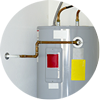Your attic and basement might not be used as much as the rest of your home, but these spaces drain energy, too. In fact, the attic and basement can be a significant source of energy loss, so it can sometimes prove to be the greatest opportunity to make your home more energy efficient.
Basement
 Basements are a common place for significant air leaks. If you have an unfinished basement or crawlspace, look for spider webs. If there is a web, there is a draft. Inspect vents, ducts, pipes, and electrical wires that lead to the outside. The Department of Energy recommends sealing small gaps with caulk, filling holes with spray foam, and covering large holes with spray foam and foamboard. Seal air ducts with mastic or foil tape and avoid cloth-backed, rubber adhesive. Be sure not to cover any of the vents for combustion appliances.
Basements are a common place for significant air leaks. If you have an unfinished basement or crawlspace, look for spider webs. If there is a web, there is a draft. Inspect vents, ducts, pipes, and electrical wires that lead to the outside. The Department of Energy recommends sealing small gaps with caulk, filling holes with spray foam, and covering large holes with spray foam and foamboard. Seal air ducts with mastic or foil tape and avoid cloth-backed, rubber adhesive. Be sure not to cover any of the vents for combustion appliances.
 Basements are particularly susceptible to poor insulation, and a large amount of heat can be lost from an uninsulated basement. While insulating the basement ceiling or floor is a less intensive project, you’ll get better energy savings by adding insulation to the walls. Hire a certified professional to determine if you need interior or exterior insulation, estimate the return on investment, and install it properly to help avoid moisture issues later.
Basements are particularly susceptible to poor insulation, and a large amount of heat can be lost from an uninsulated basement. While insulating the basement ceiling or floor is a less intensive project, you’ll get better energy savings by adding insulation to the walls. Hire a certified professional to determine if you need interior or exterior insulation, estimate the return on investment, and install it properly to help avoid moisture issues later.
 If the water heater or washer/dryer is located in the basement, check if it’s time to upgrade to newer, more energy-efficient models. Insulate your water heater, as well as ducts and hot water pipes that pass through unheated areas of the basement. If you have a little-used old refrigerator or freezer in the basement, unplug it until it is needed.
If the water heater or washer/dryer is located in the basement, check if it’s time to upgrade to newer, more energy-efficient models. Insulate your water heater, as well as ducts and hot water pipes that pass through unheated areas of the basement. If you have a little-used old refrigerator or freezer in the basement, unplug it until it is needed.
Attic
 Make sure your attic is ventilated properly. In the summer, some attic power fans can draw cool conditioned air out of the house and pull in warm air into the house, causing your A/C unit to work harder. In the winter, decrease heat loss by covering your exhaust fan using a box to seal around the duct where it opens into the attic. Check that your vents are not blocked by insulation or later construction.
Make sure your attic is ventilated properly. In the summer, some attic power fans can draw cool conditioned air out of the house and pull in warm air into the house, causing your A/C unit to work harder. In the winter, decrease heat loss by covering your exhaust fan using a box to seal around the duct where it opens into the attic. Check that your vents are not blocked by insulation or later construction.
 The attic is another location known for considerable air leakage, adding sometimes hundreds of dollars to your energy bills. Caulk wire holes and exteriors of windows and door frames, and seal around electrical boxes, air ducts, and returns. Pull-down attic stairs can be a huge source of air leakage so be sure the access door is properly sealed with weather-stripping and that it closes tightly.
The attic is another location known for considerable air leakage, adding sometimes hundreds of dollars to your energy bills. Caulk wire holes and exteriors of windows and door frames, and seal around electrical boxes, air ducts, and returns. Pull-down attic stairs can be a huge source of air leakage so be sure the access door is properly sealed with weather-stripping and that it closes tightly.
 Once you’ve finished air sealing, adding insulation to an unheated attic can make a big difference on energy savings, especially if you have hot or cold ceilings or uneven temperatures between rooms in the house. Check if you can see your ceiling joists. If so, it’s likely you need additional insulation. The Department of Energy notes that upgrading your attic insulation from three inches to 12 inches can cut heating costs by 20%, and cooling costs by 10%.
Once you’ve finished air sealing, adding insulation to an unheated attic can make a big difference on energy savings, especially if you have hot or cold ceilings or uneven temperatures between rooms in the house. Check if you can see your ceiling joists. If so, it’s likely you need additional insulation. The Department of Energy notes that upgrading your attic insulation from three inches to 12 inches can cut heating costs by 20%, and cooling costs by 10%.
By taking steps like these, you’ll be able to keep your attic and basement energy efficient and ultimately save on your electric bill.




